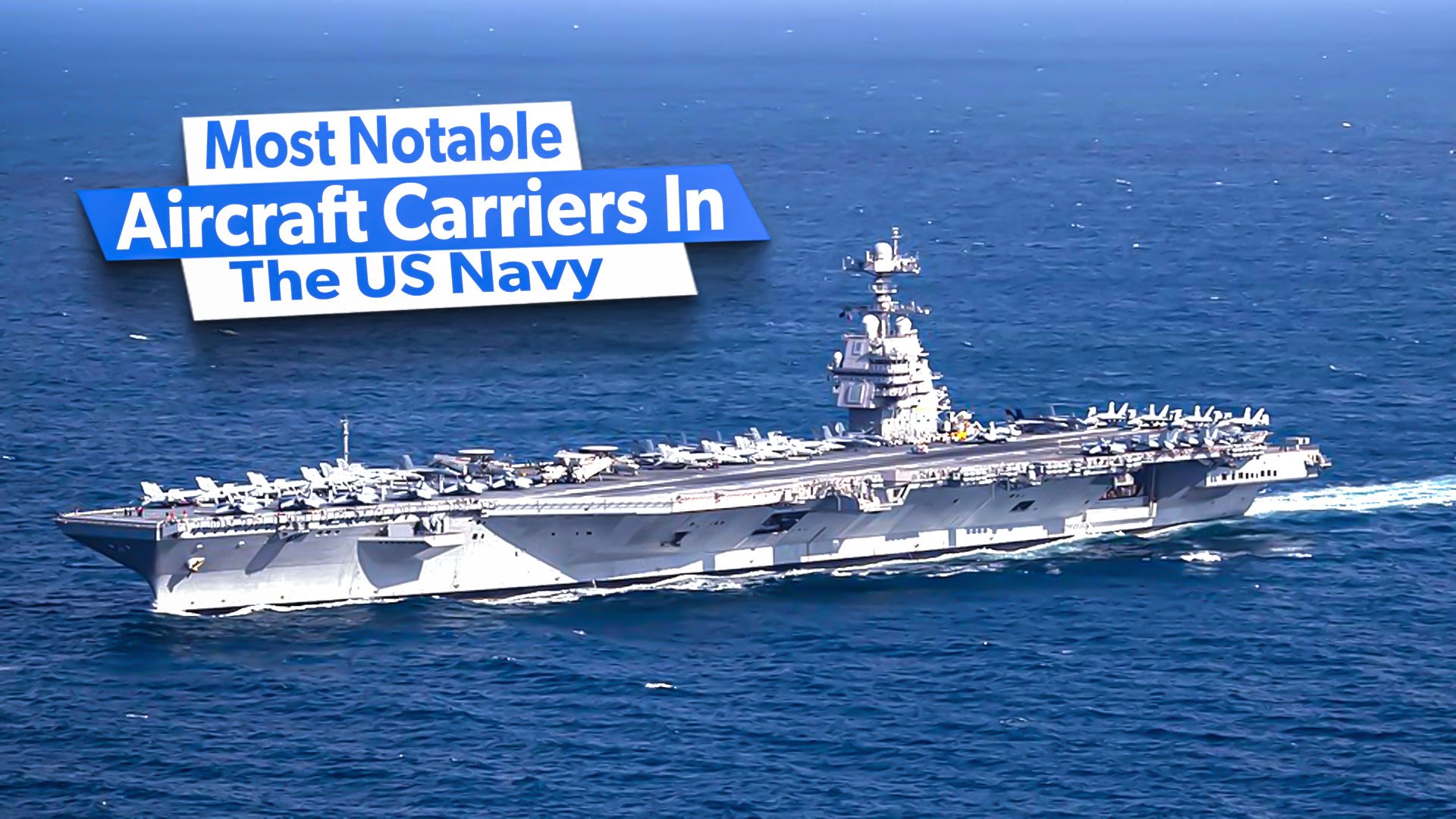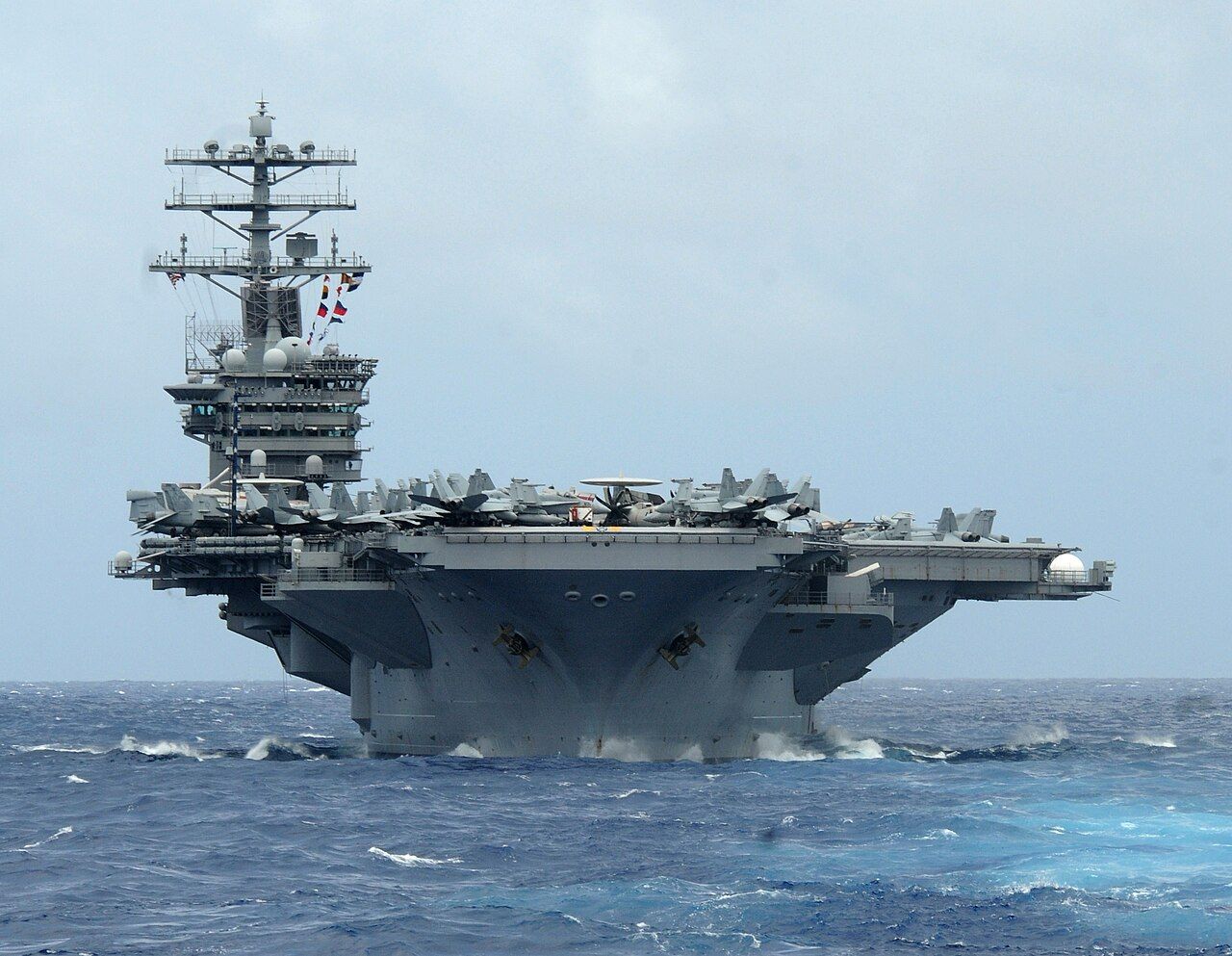The US forces’ journey with aircraft carriers began in 1920 and continues today with some of the largest and most powerful ships in the seas. Aircraft carriers serve as moving military bases and launch sites for fighter aircraft. This article explores the most notable aircraft carriers in US history.
1
USS Langley (CV-1)
Number of aircraft carried: 36
| Class and type | Langley-class aircraft carrier |
|---|---|
| Displacement | Standard: 12,700 long tons (12,904 t) Full load: 13,900 long tons (14,123 t) |
| Length | 542 ft (165.2 m) |
| Beam | 65 ft 5 in (19.9 m) |
| Draft | 24 ft (7.3 m) (as Langley) |
| Installed power | 3 × boilers, 7,200 shp (5,400 kW) |
| Propulsion | 2 × shafts, turbo-electric transmission |
| Speed | 15.5 knots (28.7 km/h; 17.8 mph) |
| Range | 3,500 NM (6,500 km; 4,000 mi) at 10 knots (19 km/h; 12 mph) |
| Complement | 468 officers and men |
The USS Langley is the first aircraft carrier used by the US Navy. In 1920, the USS Jupiter fleet collier was converted into an aircraft carrier, which was turbo-electric-powered.
The first carrier-based aircraft took place in October 1922 when a Vought VE-7 was launched from the USS Langley. Days later, the first carrier landing took place with an Aeromarine 39B touching down. The carrier has an operational range of 3,500 NM and a maximum speed of 15.5 knots.
2
USS Nimitz (CVN-68)
Number of aircraft carried: 90 (fixed wing and helicopters)
| Class and type | Nimitz-class aircraft carrier |
|---|---|
| Displacement | 100,020 long tons (112,020 short tons) |
| Length | Overall: 1,092 feet (332.8 m) Waterline: 1,040 feet (317.0 m) |
| Beam | Overall: 252 ft (76.8 m) Waterline: 134 ft (40.8 m) |
| Draft | Maximum navigational: 37 feet (11.3 m) Limit: 41 feet (12.5 m) |
| Installed power | 3 × boilers, 7,200 shp (5,400 kW) |
| Propulsion | 2 × Westinghouse A4W nuclear reactors (HEU 93.5%) 4 × steam turbines 4 × shafts 260,000 shp (194 MW) |
| Speed | 31.5 knots (58.3 km/h; 36.2 mph) |
| Range | Unlimited distance; 20–25 years |
| Complement | Ship’s company: 3,532 Air wing: 2,480 |
The USS Nimitz, a Nimitz class carrier, was first commissioned in 1975 and remains in service nearly five decades later. It is the oldest US aircraft carrier in service and also the oldest in the world.
With its length measuring over 1,000 ft, the carrier has served in a number of major missions throughout its career. It has an unlimited operational range and a maximum speed of 31.5 knots. The US forces aim to decommission the ship in 25 years, upon the end of its 50-year service life.
3
USS Lexington (CV-16)
Number of aircraft carried: 90
| Class and type | Essex-class aircraft carrier |
|---|---|
| Displacement | 27,100 long tons(27,500 t) (standard) 36,380 long tons (36,960 t) (full load) |
| Length | 820 feet (249.9 m) 872 feet (265.8 m) |
| Beam | 93 ft (28.3 m) |
| Draft | 34 ft 2 in (10.41 m) |
| Installed power | 8 × Babcock & Wilcox boilers 150,000 shp (110,000 kW) |
| Propulsion | 4 × geared steam turbines 4 × screw propellers |
| Speed | 33 knots (61 km/h; 38 mph) |
| Range | 14,100 NM (26,100 km; 16,200 mi) at 20 knots (37 km/h; 23 mph) |
| Complement | 2,600 officers and enlisted men |
The USS Lexinton is the Essex-class carrier, offering services since World War II. The carrier was first commissioned in 1943 and entered service during one of the most crucial times of naval conflict. The USS Lexington played a major role in the conflict against imperial Japan.
The ship also participated in the Kwajalein Raid, the Philippine Sea Battle, and the Leyte Gulf Battle. The carrier’s capacity, power, and range enabled superior performance in several sea fights. With an operational range of a whopping 14,100 NM (26,100 km), the ship can achieve a maximum speed of 33 knots.
4
USS Gerald R. Ford (CVN-78)
Number of aircraft carried: 75+
| Class and type | Gerald R. Ford class aircraft carrier |
|---|---|
| Displacement | About 100,000 long tons (100,000 tonnes) (full load) |
| Length | 1,092 ft (333 m) – 1,106 ft (337 m) |
| Beam | 134 ft (41 m) (waterline) 256 ft (78 m) (flight deck) |
| Height | 250 ft (76 m) |
| Decks | 25 |
| Installed power | Two Bechtel A1B PWR nuclear reactors, HEU 93.5% |
| Propulsion | Four shafts |
| Speed | In excess of 30 knots (56 km/h; 35 mph) |
| Range | ≈25 years before mid-life refuel |
| Complement | 4539 (including air wing) |
The USS Gerald R. Ford (CVN 78) is the lead ship in the Ford class of aircraft carrier. When commissioned in 2017, it became the world’s most advanced aircraft carrier. The ship cost a whopping $18 billion to build, including the cost of research and development. The technological features, including an electromagnetic catapult system, make the Ford unique in its class.
According to the US Navy,
“The USS Gerald R. Ford (CVN 78) is the most capable, adaptable, and lethal combat platform in the world, maintaining the Navy’s capacity to project power on a global scale through sustained operations at sea.”
5
USS Enterprise (CVN-65)
Number of aircraft carried: 90
| Class and type | Enterprise-class aircraft carrier |
|---|---|
| Displacement | 93,284-long-ton (94,781 t) full load |
| Length | 1,123 ft (342 m) (after refit) 1,088 ft (332 m) (original) |
| Beam | 132.8 ft (40.5 m) (waterline) 257.2 ft (78.4 m) (extreme) |
| Draft | 39 ft (12 m) |
| Propulsion | 8 × Westinghouse A2W nuclear reactors 4 x Westinghouse geared steam turbines 4 × shafts 280,000 shp (210 MW) |
| Speed | 33.6 kn (38.7 mph; 62.2 km/h) |
| Range | Unlimited distance; 20–25 years |
| Complement | 5,828 (maximum) Ship’s company: 3,000 (2,700 Sailors, 150 Chiefs, 150 Officers) Air wing: 1,800 (250 pilots, and 1,550 support personnel) |
The USS Enterprise was the first nuclear-powered aircraft carrier. Commissioned in 1961, it was equipped with eight nuclear reactors, enabling the ship to sail indefinitely or until the carrier’s lifetime.
According to the Museum of the United States Navy,
“During the Cuban Missile Crisis that October, Enterprise participated in the blockade of Cuba. Along with USS Bainbridge (DLGN-25) and USS Long Beach (CGN-9), she was part of the nuclear-task force, Operation Sea Orbit, from May to October 1964, circumnavigating the globe without refueling.”






